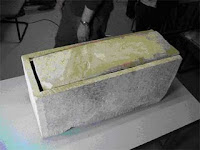In 2009 a marvellous exhibit opened at Houston's Natural History Museum on the Jewish background of Christianity, and my wife and I drove over to see it. The objects there made tangible the way people lived then, the rulers they endured, the beliefs they held. Some of the things on display put you in contact with specific individuals, on occasion even individuals you know...
Midway through the exhibit hall several ossuaries were on display. An ossuary, as I mentioned when I posted on the so-called "Jesus Family Tomb," was a stone box that you put the bones of the dead in after leaving them to rot for a year in a tomb -- a peculiar practice used only briefly by the ancient Jewish people. Most ossuaries -- about 80% -- don't even have inscriptions to tell you who is inside. The ones on exhibit did, and one in particular had a very interesting name carved into it: "Alexander, son of Simon of Cyrene." In fact, it was incised into the stone twice.
Students of the Scriptures will remember that the Roman executioners forced a random passerby to carry Jesus' cross to the infamous "Place of a Skull." This man's name was Simon of Cyrene. And in his Gospel Mark adds a parenthetical note: "He [i.e., Simon] was the father of Alexander and Rufus." You can never be certain with ossuaries but scholars feel there is a good probability that this is the final resting place of Simon's son.
Not quite the same as visiting the Church of the Holy Sepulchre I'll admit, but powerful in its own way, particularly around Easter. If I'd wanted to, I could easily have reached over the glass divider and touched the "tomb" of someone who's father stood face-to-face with Jesus of Nazareth. Probably was drenched with his blood. The son of the man who carried the cross of Christ.
That's the thing about Christianity: It's not just a collection of interesting allegorical tales; it is a narrative -- really more of an announcement -- of things that actually happened. And that announcement "is God’s power for salvation to everyone who believes," (Letter to the Romans, chapter 1 verse 16)
As the Apostle Peter said, "We did not follow cleverly devised myths when we made known to you the power and coming of our Lord Jesus Christ, but we were eyewitnesses."
And because that's true, every so often it is possible to turn a corner and run right into a man who was there at the original Good Friday.

1 comment:
I also wanted to visit this museum, but, unfortunately, it was closed, when I had an opportunity. Now, I regret that I have left the country too early.
Post a Comment